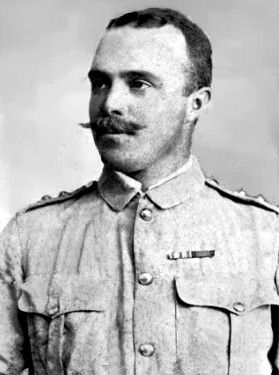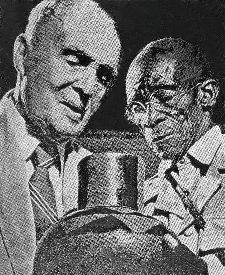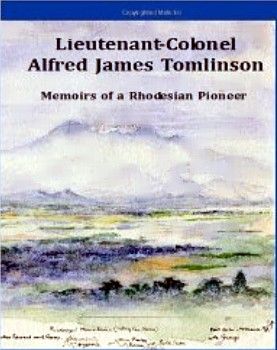The Story of Alfred James Tomlinson
Copyright (C) Family of the late Val and Denis Tomlinson, with permission.

The late Lt. Col. A.J. Tomlinson arrived in Rhodesia in 1894 as a trooper in the Bechuanaland Border Police, attested in the Mashonaland Mounted Police in October the same year and rose to the rank of Lieutenant Colonel and Acting Commissioner of the B.S.A. Police, from which force he retired in 1926 after a most adventurous, sometimes hazardous career. He was to live for another thirty-five years, residing in the country he loved and served so well, and died on his birthday at the age of 91.
Alfred James Tomlinson was born in 1870 at Madras, India. His grandfather, James Tomlinson, emigrated to India from Glasgow and there fathered 12 children, 8 of the first wife and 4 of the second. The second wife and grandmother of Alfred James, was a descendent of Lord Nelson so, in his blood, ran a little of the spirit that engendered duty to his monarch and his country, something he was to exemplify during most of the days of his life. On his mother’s side was a strong Quakerism derived from the family of Quakers named Sturge about whom a book was written in 1930 entitled The Sturges of Early Quakerism.
His father, Thomas Armstrong and his mother, Margaret, christened their first child Alfred James. This baby was to live only 24 hours and, when the third son was born, fate must have decreed they should name him after their lost one as compensation, for the new Alfred James was to outlive the whole family of 6 children. We know Alfred James was sent to England to be educated at Whitfield Grammar School but a veil seems to have been drawn over any scholastic achievements. From England he returned to India at the age of 21 when he was placed on a nominated list of the Governor of Madras Presidency for a commission in the India Police. These nominations were abolished shortly afterwards and Alfred James was appointed to the Salt and Akbari Department of the Madras Government as Assistant Inspector.
He served as a Second Lieutenant in the Malabar Volunteer Rifles in 1892 and, for what reason we do not know, he left India and arrived in Rhodesia in 1894 as a trooper in the Bechuanaland Border Police, having traveled by ox-wagon from Beira. On the 13th October the same year, he attested as a trooper in the Mashonaland Mounted Police and rose to the rank of Lieutenant a year later.
He was then 24 years of age and a bachelor, which was just as well, perhaps, in view of what was to follow during the next few years.
In September 1895,with 25 other members of the M.M.P., Alfred James left Salisbury for Bulawayo under Sub-Inspector Charles Southey. He writes in his recollections: “Our uniform was a dark grey cord tunic and breeches with black field boots and grey felt cloth hat, the brim turned up on the left side with our badge on it.” He also says in the same article: “In those days the ranks on Inspector and Sub-Inspector were equivalent to Captain and Lieutenant and the Police were known as M.M.P. - Mashonaland and Matabeleland Mounted Police “
In Bulawayo he was posted to “D” Troop under Inspector Dykes and the contingent was ordered to march through Bechuanaland to Pitsani on the Transvaal border. The numbers in camp were about 400 under Chief Inspector W. Bodle and their armament consisted of a 12½ pounder and six maxims. He goes on to say (in his recollections): “Still no word of why all this was taking place - not a whisper - but rumour had it that the native chief in the area was unruly and the force was a necessary demonstration to him and his following …
“On Sunday afternoon, December 29th 1895, a parade of all ranks was ordered without preliminary warning and Dr. Jameson (with all the staff) came along and addressed the troops.
“He gave a brief outline of how unfairly the “Uitlanders” were being treated by the Transvaal Government and went on to say they were at last driven to assert their rights …
(December 1895 … Dr. Jameson gave a brief outline of how unfairly the Uitlanders were being treated by the Transvaal Government and went on to say they were driven to assert their rights … There were cheers, and the parade was dismissed … continued ,,,)
What followed is now history – known as the Jameson Raid - and after describing their march through the night to Malmani where a mounted force of the Bechuanaland Border Police joined them under Lt.-Col. Raleigh Grey he says: “We marched on without food, until near midnight on December 31, the first skirmish with a small party of Transvaalers took place and bullets whistled. This did not last long but it made us realise there would be further fighting.”
He describes further some details of the continuing march until they reached the vicinity of Krugersdorp at 4:30 p.m. on 1st January 1896, about which he says: “The expected column from Johannesburg was not met. We reconnoitred – ‘D’ troop to the left – but the advance was quickly stopped by a withering fire from rifle pits, and we turned about, with some casualties. I remember one horse, with empty saddle, galloping with us.”
He said they were attacked three times during the night and as it grew light found their bivouac was near the railway embankment from which those “against us” could fire from cover.
The column moved on with ‘D’ Troop fighting a rear-guard action and after further comments “I found afterwards, further progress towards Johannesburg was barred by about 800 Transvaal burghers in a safe position at Doornkop.
“Their machine guns, arriving late, had just opened on us when in the midst of the din of battle, one of our trumpeters was seen to go forward with another man holding a pole on which was a large piece of white cloth and the ‘Cease Fire’ was sounded, faintly at first becoming more pronounced as firing began to die down. Then followed a stillness which was remarkable. We all gradually stood up and wondered what would take place next. (We had to surrender or we should have been wiped out)”
After capture, Lieut. Tomlinson was interrogated in the court house at Krugersdorp together with his brother officers, after which they were taken by mule wagon to Pretoria where they were put into jail. Later they were taken to Durban and placed on the S.S. Harlech Castle bound for England. All were supplied with the new clothing and given a few pounds in cash which, according to his recollections, were donated by Cecil Rhodes.
He ends this article on his recollections thus: “I might just end by saying that our force travelled 170 miles from Pitsani to Doornkop in 96 hours, the last 17 of which were continuous fighting. My memory, I think, is right when I state of the British there were 23 killed and 64 wounded.”
In later years, Alfred James loved to give people a mild shock by telling them he had been a jail-bird. When his younger son married at the outbreak of World War II, the bride’s grandparents wired her: “Congrats. Who is he?” The reply sent was enough to raise the blood-pressure of the grandparents as it read: “Son of ex-Pretoria jail-bird, letter following!”
After his exile in England, Alfred James returned to Rhodesia in time for the Matabele Rebellion of 1896. During this he was associated with a young Shona African named Rufu Majaqaba Mukangani Ncube who, some years before, had been captured by Lobengula’s warriors and taken to Bulawayo where he became a slave. His story is told in the August 1968 issue of Outpost (“Voice from the Past”) and his association with Col. Tomlinson (then a Captain) began during Lobengula’s flight from Bulawayo when Rufu escaped and, in his own words, was apprehended by a “European soldier who was cooking Capt. Tomlinson’s meal”. He became an employee of the police and he called Capt. Tomlinson his “white father” whom he never forgot.
The preliminary to Rufu’s story is in the issue of Outpost mentioned, reads thus:
“In April of this year Patrol Officer Jones of Que Que Rural was carrying out routine investigation into an Assault G.B.H. case in the Zhombe area when he came across an elderly African who identified himself as Majaqaba Mixin Ncube. In conversation with the old man – estimated by Patrol Officer Jones to be between 85 and 95 years old – the policeman discovered that he had served as a sergeant in the Force in Bulawayo, Gwanda, Belingwe, Essexvale and Fort Rixon. Mr. Ncube produced an aged and termite-ravaged photograph of himself and a “Colonel Thompson Skipper” and the connection between the two ex-members was apparently that they had served together for a long time and the photo was a souvenir of a promise made when the Colonel himself completed his service. Patrol Officer Jones forwarded the photograph and asked Outpost to look into the matter.”
“The resulting discovery is most interesting … the mysterious ‘Colonel Thompson Skipper’ was the late Colonel A. J. Tomlinson, who died on June 27 1961, and the meeting between the former Commissioner and Majaqaba was held in November 1960 when the latter presented a decorated pot to his former superior. Mr. (K.D.) Leaver spent three days recording Majaqaba’s memories of his early days and the story was translated from Sindebele and published in Volume 39 of NADA in 1962”
It was in fact through Mr. Leaver that a meeting was arranged between Mr. Ncube and Col. Tomlinson (then ninety years of age) at which the gift of the pot was made, and Mr. Ncube said (in so many words); “A gift for an old friend who saved my life and now I can die in peace.” It is probable that he, too, has now joined his ancestors but the earthenware jar remains in the family as a prized possession.
On the 16th February, 1899, Sub-Inspector (Lieut.) Tomlinson was made a Justice of the Peace for Matabeleland by His Honour William Henry Milton, administrator of the Territories of Rhodesia. Again in 1903, he was made J.P. for the Territory of Southern Rhodesia this time by Sir William Henry Milton, K.C.M.G.
When the police force was reorganised as the B.S.A.P., Alfred James remained with the corps and served in the South African War from 1899 to 1902 during which time he was promoted to Captain.

Above: Col. Tomlinson and; Mr. Ncube, meeting in November 1960. (apologies for the quality of reproduction of these very old photos).
End
Colonel Tomlinson memoirs were printed in 2011 and can be purchased from Amazon.

Click on the link below for further details
http://www.amazon.com/Lieutenant-Colonel-Alfred-James-Tomlinson-Officer/dp/1456500724?tag=airimpwrerev-20
Thanks to Trisha Jackson (granddaughter ) for affording ORAFs the permission to record these memories.
Thanks also to Angela Walker for all her assistance and also thanks to Lewis Walter that made it all possible.
Thank you folks.
Comments are always welcome, send them to Eddy Norris at orafs11@gmail.com
To view the Blog Home Page - Please Click Here.
(Please visit our previous posts and archives)


9 Comments:
This comment has been removed by the author.
Eddy Norris Writes:-
My daughter, Denise, found this information about my gradfathers brother:-
Charles J Norris, MMP 1894 No 244, he was a Tpr with the MRF in 1896 and was a member of the Jameson Raid. He was sent back to the UK on the Harlech Castle but obviously returned quickly as did many others for the ABW. He was said to be a TSM in the BSAP and died on 1/1/1900. Thus he should appear on the SAFF Casualty Roll.
At the time of the Jameson Raid he was said to be 20 yrs old and home address ; 'For Cottage', Steering, Essex. His age seems a bit young but the rank of TSM in 1900 suggests previous service
Tony Odendaal Writes:-
Something that I have not seen in the various messages about Alfred Tomlinson.
Was the BSAP training depot not named TOMLINSON Depot? So many Rhodesian (my Dad amongst them) and British recruits passed through the portals of this institution that maybe it warrants mention that it was named after this gentleman.
ORAFs has received this question from various subscribers and as such if any can prove that the Training Depot was named after Colonel Tomlinson as per the article ORAFs distributed recently.
Replies to orafs11@gmail.com please
Nick Baalbergen Writes:-
Another valuable piece of early history, not only of Alfred James Tomlinson as an individual, but also about the early history of the BSAP - Tomlinson Depot no doubt named after him
This comment has been removed by the author.
John Hill (6017 BSAP) Writes:-
The old African Police Training School [APTS] was renamed Tomlinson Depot.
Morris Depot was the training centre for the European [white] officers.
Both Depots named after former commissioners of the force – yes, same Tomlinson reported on ORAF’s
In the days of long ago and far away, I was the Quartermasters Representative for both Depots and the Support Unit who were based at Tomlinson.
Prior to that I did a spell as Chief Law & Police duties instructor at Morris Depot. Despite the fact that I was not a staff branch member and a relatively junior inspector; the fact that I was a district policeman automatically made me deputy to the Depot Chief Inspector, our equivalent of the Regimental Sergeant Major. Protocol, like the law, was an Ass!
This comment has been removed by the author.
Bob Manser (RhAF) Writes:-
Just a short note to say I have two books written by Peter Gibbs plus the old and new editions of Blue and Old Gold
Peter Gibbs editions are entitled The Right Of the Line and are in two parts with BSAP history from 1890 to 1939.
It states that AJ Tomlinson retired on 5th May 1926 and was one of the longest serving members of the force.
( In Peter Gibbs book it does name someone as being noted as the LONGEST serving member but I can't quite find the chaps name at present )
The Tomlinson Depot at which the African police are trained was named after him.
( not to be confused with Morris depot)
It says when he retired he removed the force's last link with that recurring bogey, the Jameson Raid, which had plagued its history for 30 years.
Morris Depot was named after Inspector General J.S. Morris.
It brings back fond memories of many wanderings through the depot to watch the rugby.
Great article. He was my grandfather and the kindest and most gentle man anyone could wish for. My book from his memoirs (above) is still available. I have a horse hoof from a horse called Zephyr with the D Troop brand on it.
Post a Comment
Subscribe to Post Comments [Atom]
<< Home